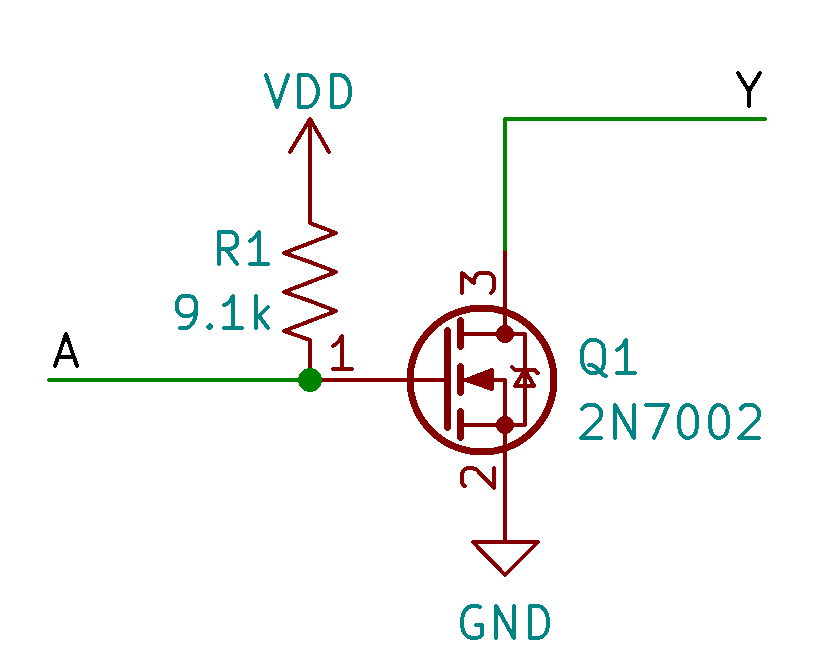
I got this old radio at a Michigan Antique Radio Club yard sale. It was a little
beat up, but a great deal–only \$15 for a radio that would have cost \$16.95 new!
The bottom has “41” and “6353” engraved on it, presumably because it is a 1941
Silvertone model 6353. It is a battery-powered “farm radio”, designed for
operation in locations that might not have electricity otherwise.
I obtained a battery-powered Silvertone radio from 1941 (model 6353). It was
originally powered with a 1.5V cell (about 250mA) to heat the filaments, and a
90V battery (about 11mA) for the anode voltage. To test my radio, I needed a
power supply.
I used a flyback converter like Jon Evans’ battery replacement
for a similar radio. The high-voltage supply is regulated by the flyback and an
LM317 regulates the filament supply from a second output.
Commercial emitter-coupled logic (ECL) can be extremely fast, with propagation
delays on the order of 1ns, which is why I wanted to learn how to use it to
maybe build a processor faster than the 75kHz VMP.
There have been other hobbyists who have built extremely fast discrete ECL
circuits using RF transistors, like this 100MHz flip flop
and this 312MHz ring oscillator,
but I wanted to see how fast I could get with the cheap 2N3904 transistors I had
on hand. My flip flop works up to 70MHz with 47mW power dissipation.
I built a flip-flop using 2N3904 transistors. With the inverting output
connected to the input, it toggles accurately with clock frequencies reaching
40MHz. It consumes approximately 25mW.
How ECL works
See next post, where I plan to actually do the math and design something better.
Design and simulation
I copied a bunch of schematics I found on the Internet into LTSpice and then
played with the values until it worked.
This is what I ended up with:
I unlocked a Baofeng GM-5RH GMRS radio to transmit on non-GMRS frequencies by
reflashing it with firmware from Amo Xu’s 5RM/5RH reverse engineering project.
The hardware of the GM-5RH is identical to the UV-5RH ‘L’ version with an
AT1846S transceiver chip, so I was able to just wipe and reflash the MCU through
its SWD port and turn the GM-5RH into a UV-5RH.
I attempted to use the firmware upgrade tool to ‘update’ the radio over its
serial port, but it was unable to connect. The GMRS version has a different code
to start programming frequncies than other radios, so perhaps it also has a different
code to start a firmware upgrade. Other people
have successfully flashed using the normal tool.
Yesterday I was working on my Manjaro Linux laptop when everything slowed to a crawl. I determined the cause to be extremely slow disk write speeds (slow as in maxed out at 2MB/s with the activity light solid on). The drive is a half-full 1TB SATA SSD (T-Force Vulcan Z) that is less than a year old, so I wasn’t expecting it to fail, but I checked the SMART diagnostics anyway. It was mostly fine, other than a pre-fail warning for the number of bad blocks. Out of curiosity I decided to calculate how much data I had written to it using the statistics for the lifetime number blocks written. The total data written came out to about 998GB– almost exactly the size of the drive!
This awesome piece of hardware was claimed to be a punched paper tape reader controller from 1962. I, with no hesitation, picked it up.

Opening it up confirmed that it was indeed awesome, although the chip date codes put the manufacture date closer to 1970. The right-hand side is taken up by a gigantic transformer and smoothing capacitor. The left-hand side is a group of five logic boards, with a sixth routing the signals from the front panel and connectors to the backplane. The six boards are connected with a big wire-wrapped backplane.
Why not?
I’ve already built something that could be considered a computer. It can’t run native code besides what is on its ROM, so it can’t run a conventional operating system, but it seems like its flaws could be easily rectified. Maybe a bigger 32-bit processor with more registers and a bigger address width could run an operating system. It could, kind of, but a real computer has a more features that are necessary to run an operating system.

I found this King KI 266 DME Indicator, part of a 1970s DME radio navigation system that would have been mounted in an airplane cockpit. I only have the display part, so unfortunately I won’t be able to use it to navigate, but it does have two awesome gas-discharge seven-segment Panaplex displays. These types of displays operate similar to Nixie tubes (high voltage makes the neon glow), but each cathode is a segment instead of an entire number.

Choices, choices…
There are lots of ways to do digital logic.
I choice NMOS because I wanted to.
For the N-channel MOSFETs, I chose 2N7002 in SOT-23 because it was the cheapest. I ended up with 9.1k pullup resistors and 12V supply because it was convenient and seemed to be a reasonable speed compromise (a few hundred ns switching time / 16mW static power). Parts are $0.032/inverter at quanity and cover about 20mm² of board area in 0805/SOT-23.



